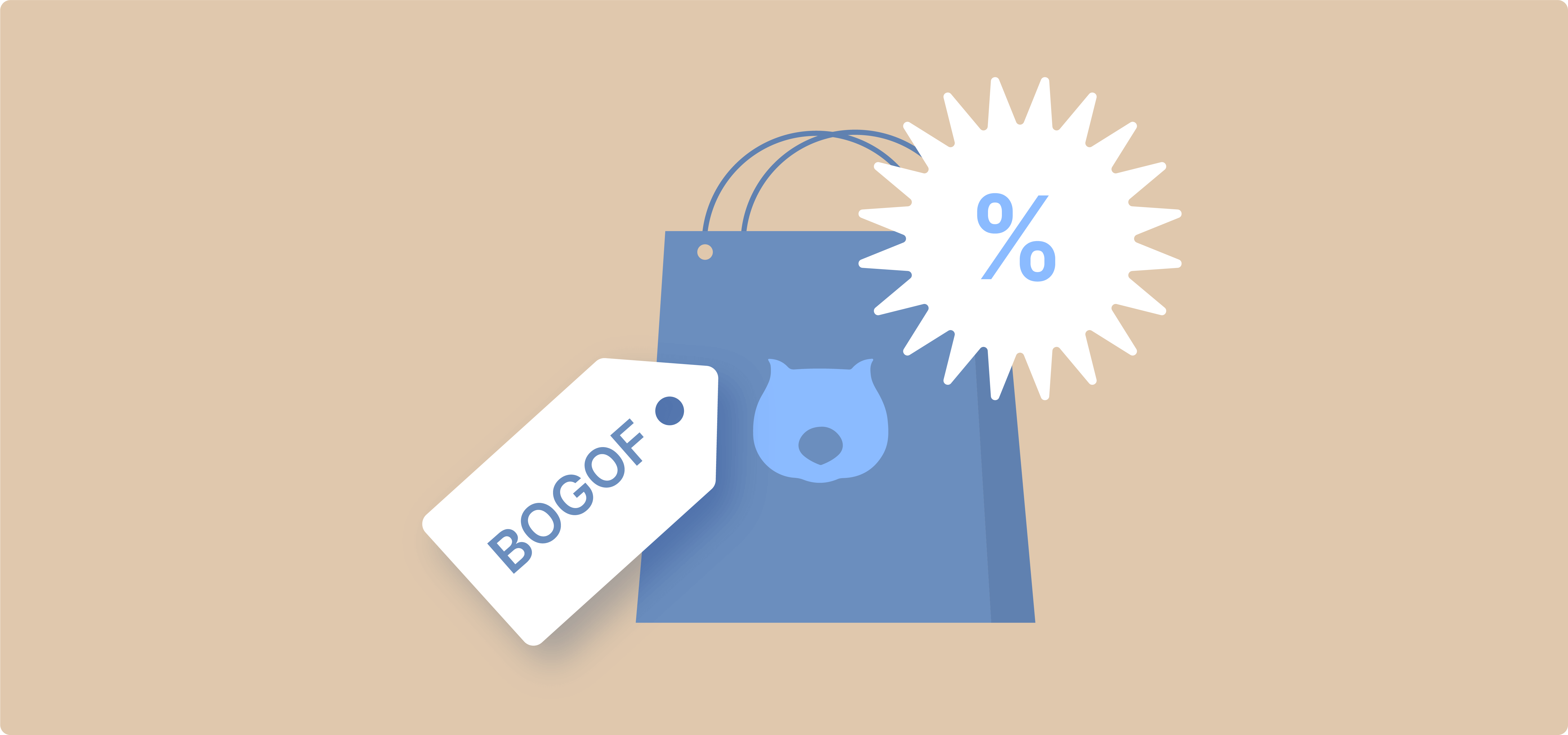Conditional discounts in WooCommerce are targeted promotions that apply only when specific criteria are met. They are often used by businesses to improve sales, foster customer loyalty, and help manage inventory effectively. Whether you’re looking to reward big spenders, entice new customers, or clear out slow-moving stock, conditional discounts can help with that.
There are three main types of conditional discounts: cart-based, user-specific, and product/category-specific. Each type serves different business goals and can be tailored to your unique needs.
While WooCommerce’s built-in discount system is limited, plugins like WooCommerce Discounts can unlock the full potential of conditional discounts. This article will guide you through successful strategies and provide step-by-step instructions on setting up these discounts, helping you maximize your e-commerce success.
Step-by-step guide to conditional discount strategies for WooCommerce
Let’s explore three primary types of conditional discount strategies for WooCommerce: cart-based, user-specific, and product/category-specific discounts. Each strategy offers unique benefits and can be customized to meet various business objectives. We’ll start with cart-based discounts.
Cart-based discounts
Cart-based discounts are applied based on the contents of a customer’s shopping cart. These discounts can encourage higher order values and motivate customers to purchase more items to qualify for a discount.
Here are some common types of cart-based discounts:
- Percentage discounts: For example, 10% off orders over $100.
- Fixed amount discounts: Such as $20 off when you spend $150.
- Item quantity discounts: Like buy 3, get 1 free.
Now, let’s see how you can set up a store-wide sale with a flat 20% discount and a condition for a cart total minimum of $100 using WooCommerce Discounts:
- Go to WooCommerce → Marketing → Discounts, click Add New and choose Flat discount.

- Choose a name for your discount and set the scheduled dates if you want this to happen in a specific timeline.

- Enter the discount amount (e.g. 10%) and choose whether you want this to apply only to a specific product group.
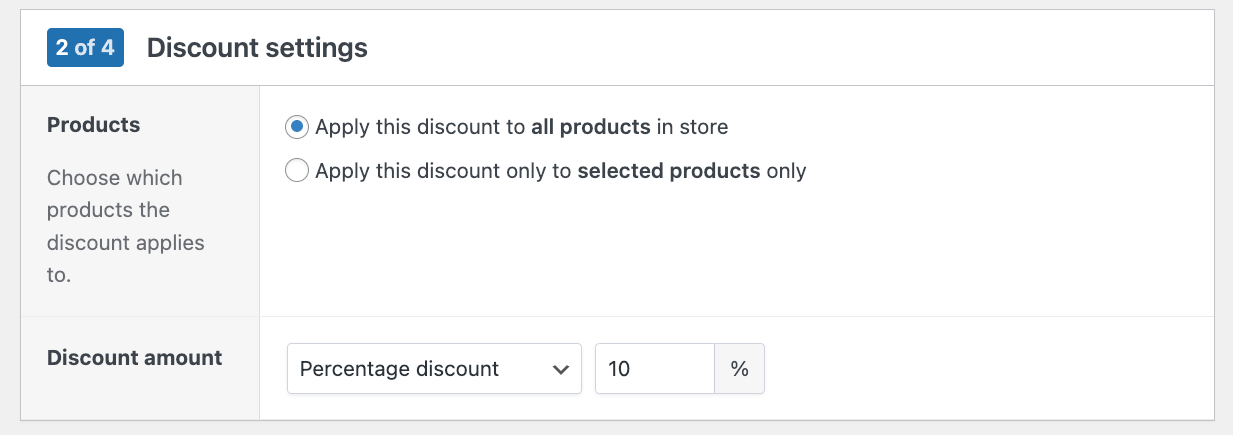
- When you get to the final step, select “This discount needs extra conditions.”

- Add 2 conditions: “Cart subtotal” → “is more than” → “$100” and “Cart subtotal” → “is equal to” → “$100.”
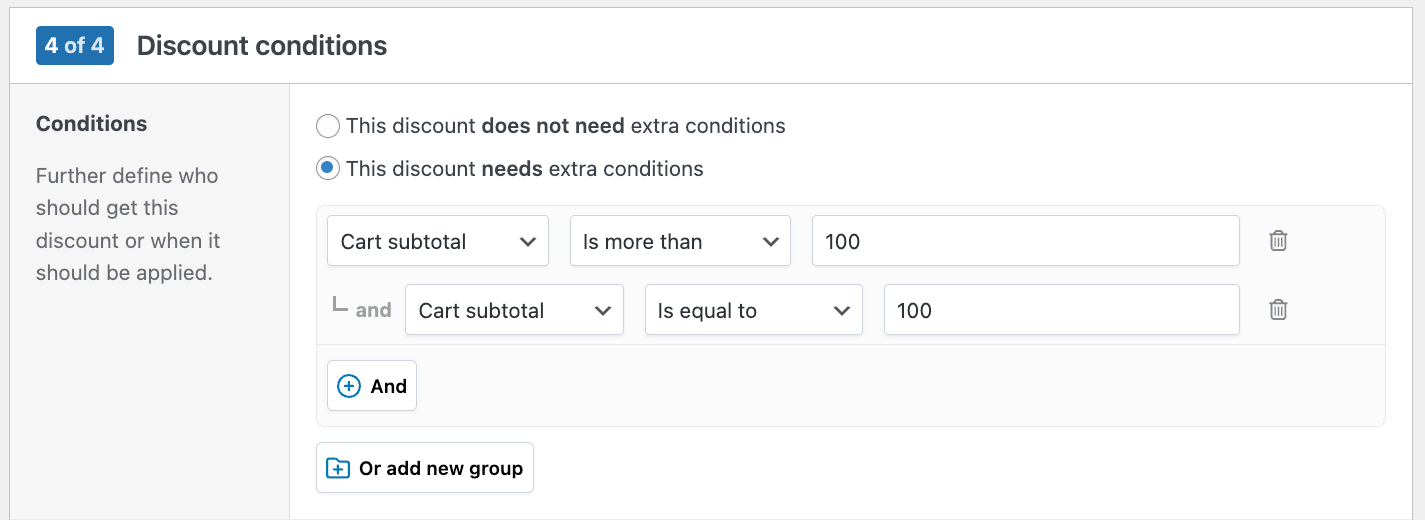
- Save your discount.
User-specific discounts
User-specific discounts target particular customer segments to foster loyalty and encourage repeat purchases. These discounts can be personalized based on user roles, purchase history, or other criteria. Here are some common types:
- New customer discounts: For example, 15% off the first purchase.
- Loyalty discounts: 10% off for returning customers or newsletter subscribers.
- Role-based discounts: Special pricing for premium members or wholesalers.
To set up a user-specific discount for wholesalers using WooCommerce Discounts:
- Create a discount the same way we did in the previous example.
- When you get to the last part, choose “This discount needs extra conditions” again.
- This time, set the condition: “User role” → “Any in list” → “Wholesaler.”

- Save your discount.
Product- and category-specific discounts
Product- and category-specific discounts are powerful tools for managing inventory and driving sales of particular items. These discounts can help you:
- Clear out slow-moving stock: Offer a 30% discount on last season’s winter coats to make room for new inventory.
- Promote high-margin items: Apply a 10% discount to your premium product line to attract more customers to these profitable items.
- Boost sales in underperforming categories: Create a “15% off” promotion for your entire kitchenware category to stimulate interest.
- Bundle related products: Offer a 20% discount when customers buy a camera and a memory card together.
For example, a bookstore might offer a 25% discount on all science fiction novels during a month-long genre promotion, potentially attracting new readers and clearing out older titles.
Now, let’s see how you can do this:
- Create a new flat discount with WooCommerce discounts.
- Name it appropriately and set the month-long sale timeline.
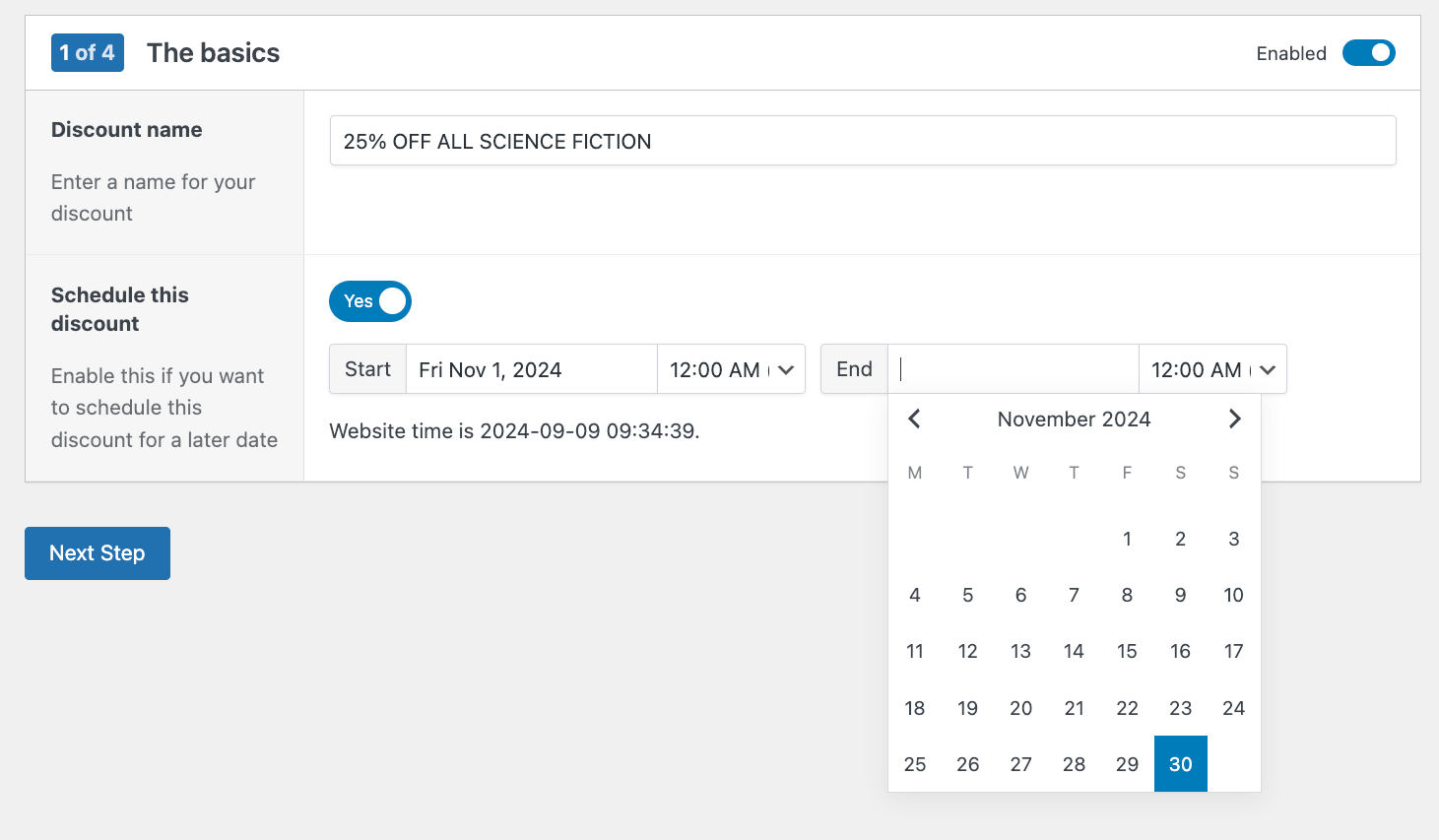
- Select “Apply this discount only to selected products only” and click on Add products.
- Create the condition “Product category” → “Is” → “Science fiction” and then set the discount amount to 25%.
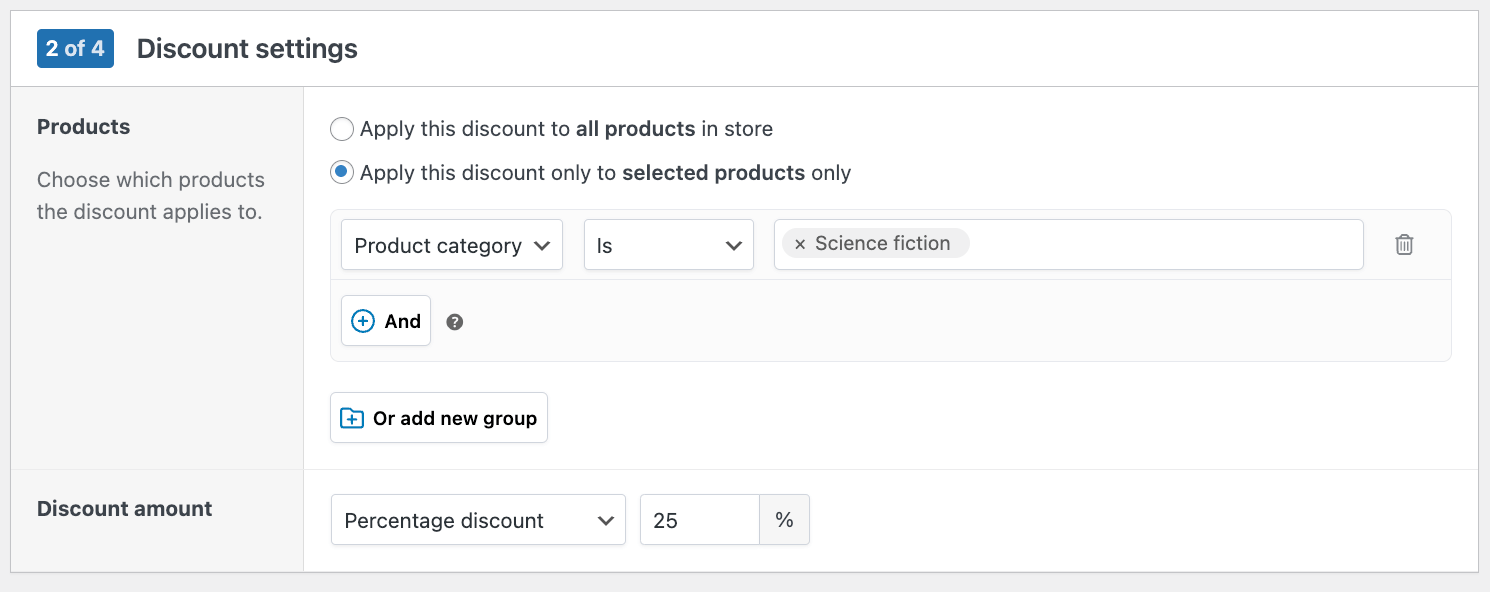
- In the next step, create an enticing message to appear on all eligible product pages.
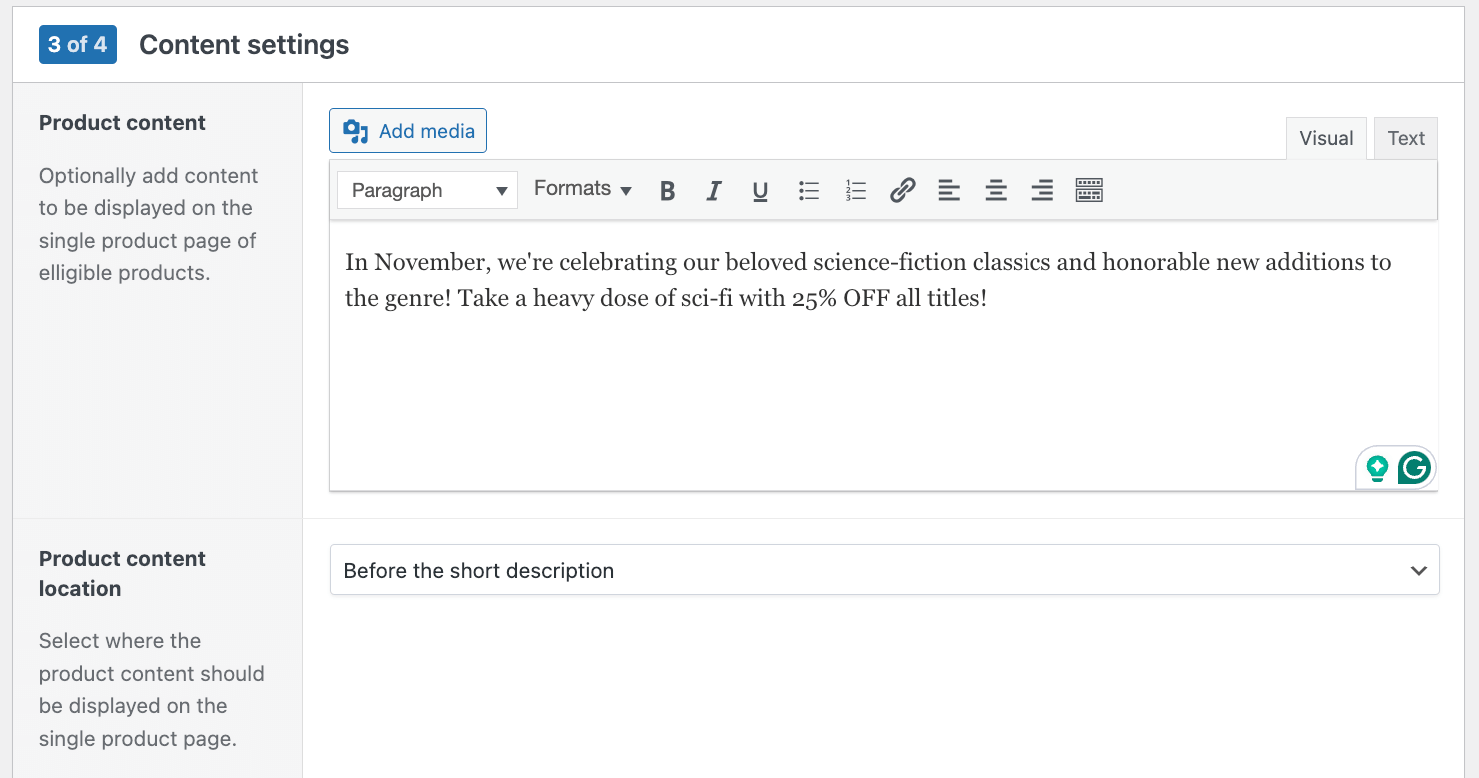
- Save your settings, and you’re done!
Combining different types of discounts
Combining multiple discount conditions creates a dynamic pricing structure that can target specific customer behaviors and achieve complex business goals. Here are some examples:
- Cart total + User role: Offer VIP customers (user-specific) a 15% discount on orders over $200 (cart-based).
- Example: “15% off for Gold Members on orders over $200.”
- Product category + Quantity: Give a 10% discount on electronics (category-specific) when buying 3 or more items (cart-based).
- Example: “10% off when you buy 3 or more items from our Electronics category.”
- New customer + Specific product: Offer first-time buyers (user-specific) a 20% discount on your flagship product (product-specific).
- Example: “20% off our Premium Coffee Maker for new customers.”
- Seasonal + Cart total: During summer (time-based), offer free shipping (cart-based) on orders over $50.
- Example: “Free shipping on orders over $50 – Summer Special!”
- Bundle discount + User history: Customers who previously bought a laptop (user-specific) get 30% off on laptop accessories (product-specific).
- Example: “30% off laptop accessories for previous laptop buyers.”
Best practices for setting up conditional discounts
Implementing conditional discounts effectively requires careful planning and execution. Here are some best practices to help you maximize the impact of your discount strategies in WooCommerce:
1. Plan your discount strategy
Before diving into setting up discounts, take time to outline your goals and strategy:
- Identify specific objectives: Are you aiming to increase average order value, clear out excess inventory, attract new customers, or reward loyal ones? Each goal may require a different approach.
- Target audience: Understand your customer segments and tailor discounts to different groups. For example, offer a “welcome” discount to new customers or a “loyalty” discount to frequent buyers.
- Timing matters: Plan discounts around key dates like Black Friday, holiday seasons, or your store’s anniversary. Also, consider your industry’s specific peak and off-peak seasons.
Example: A fitness equipment store might offer a “New Year, New You” 15% discount on all exercise bikes in January, targeting resolution-makers looking to get in shape.
2. Use data-driven insights
Leverage your store’s data to inform your discount strategies:
- Analyze past performance: Review the success of previous discount campaigns. Which types of discounts resulted in the highest conversion rates or largest increase in average order value?
- Study customer behavior: Use analytics tools to understand purchasing patterns. Are there particular products that customers often buy together? This could inform bundle discounts.
- Adjust strategies: Continuously refine your approach based on data insights. If a certain discount isn’t performing well, don’t be afraid to modify or replace it.
Example: After analyzing data, an online homeware store notices that customers who buy cookbooks often return within a month to purchase kitchen gadgets. They create a discount offering 10% off kitchen items for customers who previously bought a cookbook, resulting in increased cross-category sales.
3. Communicate discounts effectively
Even the best discount strategy won’t work if customers don’t know about it:
- Clear messaging: Ensure discount offers are clearly communicated on your website. Use prominent banners, pop-ups, or dedicated sections to highlight current promotions.
- Product pages: Display applicable discounts directly on product pages. This can help push hesitant customers toward a purchase.
- Email marketing: Notify your email subscribers about ongoing and upcoming discounts. Segment your list to send targeted discount offers to specific customer groups.
- Social media: Leverage your social media platforms to spread the word about your promotions. Create engaging posts that showcase the value of your discounts.
Example: A beauty product store creates eye-catching graphics for their “Buy 2, Get 1 Free” promotion on face masks. They display these on their homepage, product pages, and share them across their social media channels, resulting in a significant uptick in sales of face masks.
4. Monitor and optimize
Implementing discounts is not a “set it and forget it” task; you need to constantly monitor and optimize your strategies. Here’s how you can do that:
- Track performance: Use analytics tools to monitor the performance of your discount campaigns in real time. Key metrics to watch include redemption rates, average order value, and overall revenue impact.
- Customer feedback: Collect and analyze customer feedback about your discounts. Are they easy to understand and use? Do customers find them valuable?
- A/B testing: Experiment with different discount types, amounts, and conditions to find the most effective strategies. For example, test whether a percentage discount or a fixed amount discount performs better for a specific product category.
- Iterate and improve: Based on your findings, continuously refine your discount strategies. What works well for one product or customer segment might not work for another.
Example: An electronics store notices that their flat 10% discount on laptops isn’t driving as many sales as expected. They decide to A/B test this against a “$100 off laptops over $800” discount. The second option performs significantly better, likely because the concrete dollar amount feels more valuable to customers making larger purchases.
5. Avoid common pitfalls
Be aware of these common mistakes when implementing conditional discounts:
- Over-discounting: Offering too many discounts can devalue your products and hurt your profit margins. Be strategic and selective with your promotions.
- Complicated conditions: If your discount rules are too complex, customers may get confused or frustrated. Keep conditions clear and straightforward.
- Ignoring profitability: Always calculate the impact of discounts on your bottom line. Ensure that your discounts are driving enough additional sales to offset the reduced margins.
- Neglecting regular customers: While attracting new customers is important, don’t forget to reward your loyal customers. Balance your discount strategy to cater to both groups.
Example: A clothing store offers a “30% off your entire purchase” discount to boost sales. While it drives a large volume of orders, the store’s profit margins suffer significantly. They adjust their strategy to offer more targeted discounts, such as “30% off when you buy 5 or more items,” which maintains healthy margins while still incentivizing larger purchases.
Maximize the impact of your conditional discounts with WooCommerce Discounts
Conditional discounts offer a powerful way to give your store a nice boost in sales, create a better experience for your customers, and manage inventory effectively.
While WooCommerce’s built-in capabilities are limited, the WooCommerce Discounts plugin provides an affordable and user-friendly solution. Its intuitive interface allows for easy implementation of all the discount types we’ve discussed and more, enabling you to create a truly dynamic pricing structure.
For even more customization, consider combining WooCommerce Discounts with other Studio Wombat plugins. For instance, use it alongside Advanced Product Fields for WooCommerce to create discounts based on custom product options, or pair it with WooCommerce Quantity Discounts, Rules & Swatches for advanced bulk pricing strategies.
Ready to revolutionize your pricing strategy? Try WooCommerce Discounts today and see the difference it can make for your store!
